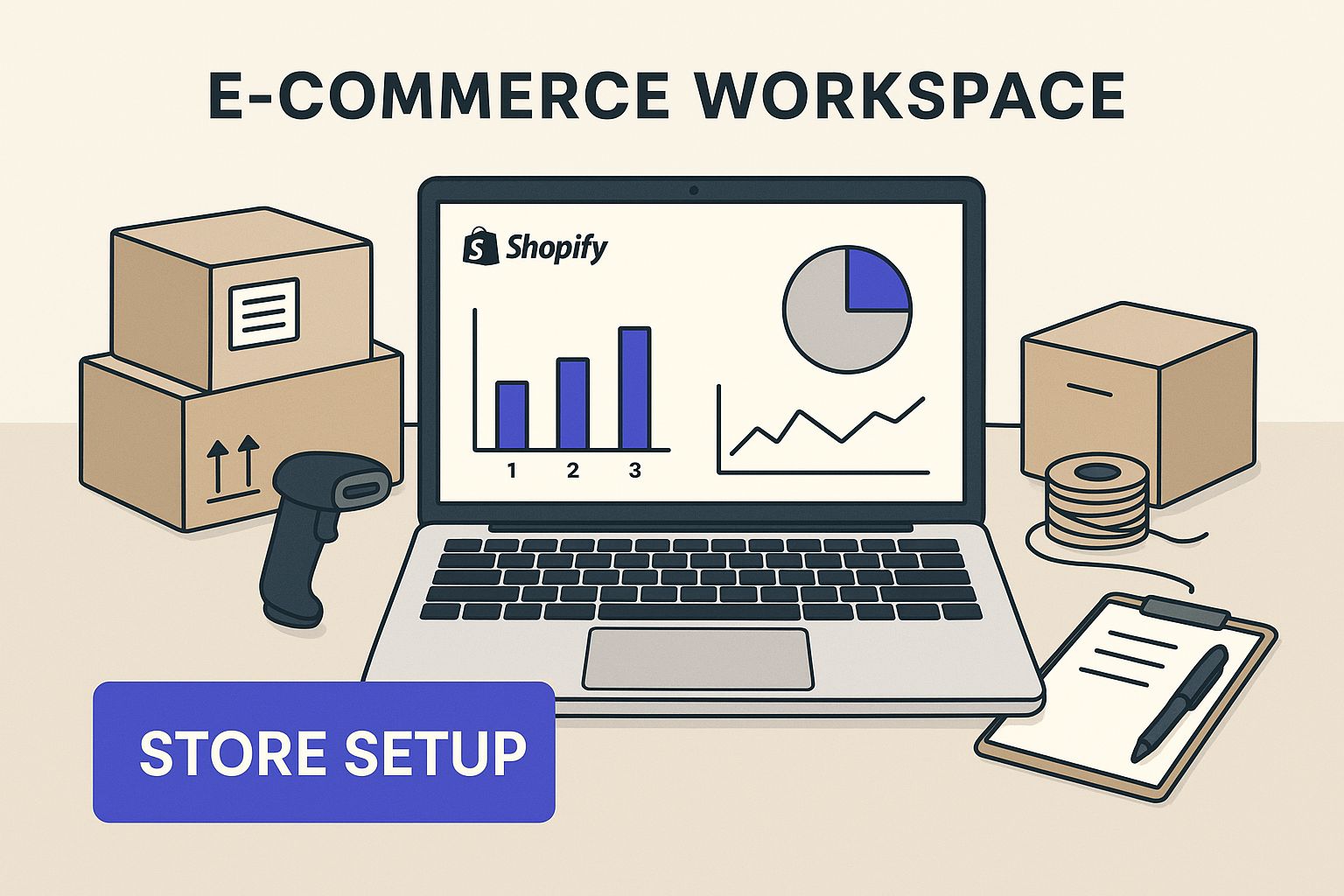Why Shopify Outshines Dedicated Course Platforms
Selling courses online requires a platform that handles both learning management and the business side of things. While dedicated course platforms offer structured learning, they often lack the robust ecommerce features of Shopify. This is where Shopify excels, providing a powerful engine for selling courses and building a thriving online education business. This allows creators to control their brand, customer data, and revenue streams, often limited on third-party platforms.
Control and Ownership: Your Brand, Your Data
A key advantage of using Shopify for online courses is the control over your brand and customer data. Unlike dedicated platforms, Shopify lets you customize your storefront to reflect your brand. This includes your domain name, website design, and customer experience. You also own your customer data, allowing you to build direct relationships and implement targeted marketing. This ownership is vital for long-term growth and avoids vendor lock-in.
Seamless Ecommerce Integration: From Checkout to Delivery
Shopify's strength lies in its seamless ecommerce integration. Selling courses becomes as streamlined as selling physical products. This simplifies everything from checkout to delivery, without third-party tools. Shopify handles payment processing, secure file delivery, and even offers marketing tools to reach a wider audience. This integrated approach saves time, letting you focus on creating great course content.
Cost-Effectiveness: Maximize Your Profits
Shopify is often more cost-effective than dedicated platforms, especially as your business grows. Many dedicated platforms charge transaction fees or limit student/course numbers. Shopify offers predictable pricing plans, allowing you to scale without escalating costs. This scalability maximizes profit margins and builds a sustainable business. The data chart below illustrates the key distinctions between Shopify and dedicated platforms for selling courses.
| Feature | Shopify | Teachable | Thinkific | Podia |
|---|---|---|---|---|
| Branding | Full Control | Limited Control | Limited Control | Limited Control |
| Ecommerce | Integrated | Requires Integrations | Requires Integrations | Requires Integrations |
| Scalability | High | Limited | Limited | Limited |
| Cost | Predictable | Variable with transaction fees | Variable with transaction fees | Variable with transaction fees |
| Customization | Extensive via apps | Restricted | Restricted | Restricted |
This chart underscores Shopify's strengths in branding, ecommerce, scalability, cost, and customization versus dedicated platforms. This makes Shopify a strong choice for creators wanting a successful online education business.
Flexibility and Customization: Tailoring Your Course Business
Shopify’s flexibility extends to customization. You can use apps like Tevello to enhance the learning experience and tailor course delivery. You can integrate community features, memberships, and personalized learning paths. This customization, rare on dedicated platforms, creates a unique learning experience. Selling courses on Shopify is a growing market, alongside global ecommerce. In 2024, global ecommerce sales are projected to reach $6.09 trillion, demonstrating a strong market for online transactions, including courses. Shopify holds about 10.32% of the global ecommerce market and roughly 30% of the US ecommerce platform market. Find more detailed statistics here.

Building Your Course Empire: The Shopify Setup Guide
Turning your Shopify store into a thriving educational hub doesn't have to be a daunting task. This guide offers a clear path to setting up your Shopify store specifically for selling online courses. We'll explore how successful course creators optimize their stores for both student satisfaction and efficient administration.
Choosing the Right Shopify Plan for Course Sales
The first crucial step is selecting the right Shopify plan. While the Basic Shopify plan works for beginners, the Shopify plan or Advanced Shopify plan offer features that are advantageous as your course business scales. These higher tiers offer more robust reporting to track course sales and student engagement. They also have lower transaction fees, which can significantly impact your net profit as your student base grows.
Structuring Your Course Catalog for Easy Navigation
Organizing your courses effectively is key to a positive user experience. Use Collections in Shopify to group courses by subject matter, skill level, or target audience. This allows students to easily find relevant courses. Think of collections as categories or virtual shelves in your online course store. For example, a photography instructor might create collections like "Beginner Photography," "Landscape Photography," or "Portrait Photography."
Optimizing the Checkout Process for Educational Products
Shopify's checkout process can be tailored to boost course sales. For digital products like online courses, ensure clear communication about delivery (e.g., immediate access upon purchase). Offering various payment options also caters to a broader range of students. Some students might prefer one-time payments, while others might appreciate payment plans or subscriptions.
Leveraging Shopify Themes and Customizations for Course Delivery
Your chosen Shopify theme influences how students perceive and interact with your courses. Look for themes that support features like video embeds, student testimonials, and integrated blogs. These elements showcase course content and build credibility. Consider checking out resources like How to master Shopify course building on tevello.com. Further customization is possible using Shopify’s Liquid language or apps designed specifically for online courses, adding features like progress tracking and student dashboards.
Automating Administrative Tasks for a Streamlined Workflow
As your course business grows, automation becomes indispensable. Shopify's Flow feature automates tasks such as adding students to email lists, granting course access after purchase, and sending reminder emails. This frees up your time to focus on creating valuable content and interacting with students. Think of Flow as your virtual assistant, handling repetitive tasks behind the scenes.
By implementing these strategies, you can effectively utilize Shopify's ecommerce capabilities to create a professional and profitable online course business.
The Course Creator's App Arsenal: Tools That Deliver

Successfully selling online courses on Shopify hinges on choosing the right apps. These apps expand Shopify's core functionality, turning your store into a robust learning hub. This section explores essential apps that handle key aspects of course delivery and management.
Content Protection and Access Control: Safeguarding Your Intellectual Property
Protecting your course content is crucial. Apps like Sky Pilot offer strong digital rights management (DRM), preventing unauthorized downloads and sharing. This safeguards your investment and ensures only paying students can access your valuable materials. Other options, such as MemberVault, offer gated content, controlling access based on membership levels or course completion.
Progress Tracking and Assessment: Keeping Students Engaged and Motivated
Tracking student progress benefits both the student and the instructor. Apps like Courseflow and Progressly let you monitor student engagement, quiz scores, and overall completion rates. This data helps pinpoint areas where students may be struggling, allowing you to adjust your teaching approach. These tools also empower students to see their progress, a powerful motivator for completing the course. For more information on useful tools for online educators, check out this resource: Key Tools for Online Educators.
Communication and Community Building: Fostering a Vibrant Learning Environment
Building a community around your courses greatly enhances the learning experience. Apps like Mighty Networks and Circle facilitate student discussions, forums, and Q&A sessions. This fosters a supportive environment where students learn from one another and connect. This is especially beneficial for cohort-based programs, where interaction and collaboration are essential.
Seamless Integrations: Connecting Your Course Ecosystem
Choosing apps that integrate seamlessly with your existing Shopify setup is essential. Prioritize apps that work smoothly with your theme and other vital tools, like email marketing platforms such as Klaviyo and Mailchimp. This prevents technical issues and ensures a smooth, consistent experience for everyone. One standout in this space is Tevello, a Shopify-native app built specifically for course creators. Tevello offers an all-in-one solution that combines course delivery, community features, and student progress tracking—without requiring third-party platforms or complicated workarounds. Because it’s designed to work directly within Shopify, you get a unified system that handles everything from onboarding to engagement, helping you streamline operations and maintain full control of your user experience.
Shopify's ability to manage high transaction volumes is also key. During the 2023 BFCM weekend, Shopify merchants processed over $9.3 billion in sales, with peak per-minute sales surpassing $4.2 million. Discover more insights about Shopify's transaction capacity.
Considering Costs and Learning Curves: Making Informed Decisions
Before choosing an app, carefully evaluate its pricing and learning curve. Some apps offer free trials or freemium plans, letting you explore features before committing. Others have monthly or annual subscriptions. Tevello, for instance, offers a comprehensive solution, integrating course delivery and community features within Shopify. Consider your needs and budget to find the best fit. Look for apps with excellent customer support and documentation to minimize setup time and maximize efficiency.
Here's a helpful table summarizing some popular options:
To help you make the best decision, we've compiled a table highlighting some of the top Shopify apps for course creators:
Top Shopify Apps for Course Creators: An overview of the most effective Shopify apps for course delivery, highlighting key features and pricing
| App Name | Primary Function | Key Features | Price Range | Best For |
|---|---|---|---|---|
| Tevello | All-in-one platform | Courses, memberships, community, integrated checkout | $29/month | Creators wanting a unified solution within Shopify |
| Sky Pilot | Content Protection | DRM, watermarking, license keys | Varies based on usage | Creators concerned about piracy |
| MemberVault | Access Control | Gated content, membership tiers, course bundles | Starting at $49/month | Membership site owners |
| Courseflow | Progress Tracking | Student dashboards, progress analytics, quizzes | Contact for pricing | Educators focused on student engagement |
| Progressly | Progress Tracking | Checklists, gamification, certifications | Starting at $29/month | Skill-based course creators |
| Mighty Networks | Community Building | Forums, groups, live events | Starting at $39/month | Cohort-based programs |
| Circle | Community Building | Discussions, memberships, direct messaging | Starting at $39/month | Creators seeking a dedicated community platform |
This table provides a starting point for your research. Each app offers unique strengths, so explore the options that align with your specific needs and budget. Remember to leverage free trials and demos to make informed decisions.
Pricing Psychology: Packaging Courses For Maximum Profit
Selling online courses on Shopify demands a strategic pricing approach to maximize profit. It's not just about calculating costs and adding a markup. Understanding pricing psychology and how to present your courses effectively is crucial for resonating with potential students and driving revenue.
Tiered Pricing: Offering Options That Cater to Different Needs
Tiered pricing offers various levels of access and content at different price points. This strategy allows you to cater to a broader audience with varying budgets and learning objectives.
- Basic Tier: Provides core course content.
- Premium Tier: Includes additional resources and personalized feedback.
- Elite Tier: Offers one-on-one coaching sessions.
This flexibility empowers students to choose the option that best suits their individual needs and financial resources.
Bundling: Creating Irresistible Package Deals
Bundling combines multiple courses or resources into a single package deal, typically at a discounted price compared to individual purchases. This approach enhances the perceived value for students and increases your average order value.
- Bundle related courses.
- Offer supplementary materials within a package.
- Include access to a community forum.
Creating bundles that provide a strong combination of value and cost savings is key. For a deeper dive into pricing strategies, check out this article on how to master online course pricing.
Subscription Models: Generating Recurring Revenue
Subscription models grant ongoing access to content and resources for a recurring fee. This strategy generates a predictable revenue stream for your business and provides students with continuous learning opportunities.
- Offer subscriptions for individual courses.
- Create subscriptions for bundles of courses.
- Provide subscription-based access to a resource library.
This cultivates a loyal student base and delivers sustained value over time.
Scarcity and Urgency: Encouraging Timely Enrollment
Creating a sense of scarcity or urgency can motivate potential students to enroll quickly. This can be accomplished through limited-time offers, early bird discounts, or limited enrollment periods. However, always prioritize ethical practices and avoid manipulative tactics that could harm your reputation.
International Pricing and Tax Considerations
Selling courses globally necessitates implementing international pricing strategies and addressing tax complexities. Research local market conditions and adjust your pricing accordingly to optimize conversions in different regions. Compliance with international tax regulations is essential for maintaining a legitimate and thriving business.
By implementing these pricing strategies, you can go beyond basic pricing models and establish a powerful revenue engine for your online course business on Shopify. Regularly analyze your pricing and adapt your approach based on student feedback and market trends to ensure you are maximizing your profit potential while delivering valuable learning experiences.
Converting Browsers to Students: The Marketing Blueprint

Creating top-notch courses is only half the journey when selling on Shopify. The other half lies in effective marketing, transforming casual browsers into enrolled students. This requires a strategic approach, blending Shopify's built-in marketing tools with external strategies.
Optimizing Course Product Pages for Conversions
Your course product page serves as your digital storefront. It's the deciding point for potential students considering investing in your expertise. Optimizing these pages is essential. Engaging preview videos showcasing your teaching style and course content are vital.
For instance, a short, captivating video highlighting key takeaways and student testimonials can significantly increase conversions. Social proof, like student reviews and testimonials, builds trust and credibility.
Clearly stating learning outcomes and the course's value proposition helps potential students understand the benefits. A well-designed page with high-quality images and a clear call to action enhances the user experience and boosts enrollments.
Pre-Launch Buzz and Email Marketing Strategies
Creating anticipation before a course launch is crucial for generating initial interest. This might include early bird discounts, waitlists, and sharing content previews on social media platforms. Email marketing plays a critical role in nurturing leads and guiding them toward enrollment.
A well-structured email sequence can introduce your course, highlighting its advantages and addressing any hesitations. An example email series could begin with valuable free content related to the course, transition into details about the course itself, and conclude with a limited-time offer. Abandoned cart recovery emails can recapture lost sales and remind potential students of the value they're missing.
Content Marketing for Long-Term Growth
Content marketing is an effective tool for building authority, attracting organic traffic, and capturing qualified leads. Creating valuable blog posts, articles, videos, and related content establishes you as an expert. This builds trust and draws potential students actively seeking information in your field.
Sharing this content on social media and optimizing it for search engines (SEO) expands your reach. By consistently delivering free, valuable content, you nurture relationships with potential students and guide them towards your paid courses. This sustainable system attracts qualified prospects, fostering long-term growth for your online course business. This approach lets your expertise shine, naturally leading interested individuals to your course offerings.
Crafting Student Experiences That Create Raving Fans
Building a successful online course business on Shopify goes beyond simply uploading videos and setting a price. The real key to standing out is the student experience. This means creating a learning environment that encourages engagement, helps students complete the course, and builds a loyal community who will happily recommend your courses.
Onboarding: Setting Students Up for Success
First impressions matter. A well-designed onboarding process sets the stage for the whole learning journey. Think of it as welcoming students to your virtual classroom. This includes giving clear instructions on accessing materials, navigating the platform, and engaging with the community. A welcome email with a personalized video from the instructor can make a strong initial connection.
Designing for Clarity and Reducing Friction
Confusion and frustration make learning difficult. Design your courses with clarity as a priority. This means structuring content logically, having intuitive navigation, and providing clear instructions. Minimize technical issues and distractions to help students stay focused. Imagine a well-organized library where students can easily find the information they need.
Building a Community: Transforming Solitary Learning
Learning doesn't have to be lonely. A strong online community around your courses fosters connection and collaboration. This might involve a dedicated forum, live Q&A sessions, or peer feedback. This transforms learning from passive consumption to active participation, much like study groups in a traditional classroom.
Balancing Automation With the Personal Touch
Automation streamlines administrative tasks, but maintaining a human touch is essential. This means incorporating personalized communication, giving individual feedback, and responding to student questions. Think of it as balancing automated emails with opportunities for one-on-one interaction, similar to office hours with a professor.
Implementing Feedback Loops for Continuous Improvement
Student feedback is incredibly valuable. Set up systems to collect and analyze feedback to find areas for improvement. This shows you care about quality and helps you tailor content to student needs. Surveys and feedback forms can provide helpful insights.
Retention Strategies: Encouraging Continued Learning
Keeping students engaged after they buy your course is key for long-term success. Retention strategies could include discounts on future courses, access to exclusive content, or a loyalty program. This provides ongoing value and encourages continued learning.
Managing Refunds and Access: Setting Clear Expectations
Being upfront about refunds and access periods builds trust. Clearly explain your policies to avoid confusion and maintain positive student relationships. This includes explaining refund criteria and the length of course access. A satisfaction guarantee period can reassure potential students.
Providing Support Without Burnout: Setting Boundaries
Supporting students is crucial, but setting healthy boundaries is important to avoid burnout. Establish clear communication channels and reasonable response times. Using automation and FAQs can help manage student questions efficiently. This lets you provide support without sacrificing your own well-being.
Selling courses on Shopify offers many possibilities for a successful online education business. By prioritizing the student experience and using these strategies, you can build a loyal community who become enthusiastic advocates for your courses.
Ready to turn your Shopify store into a thriving educational hub? Tevello seamlessly integrates courses and communities into your Shopify store, empowering you to create excellent student experiences and build a thriving online course business.




